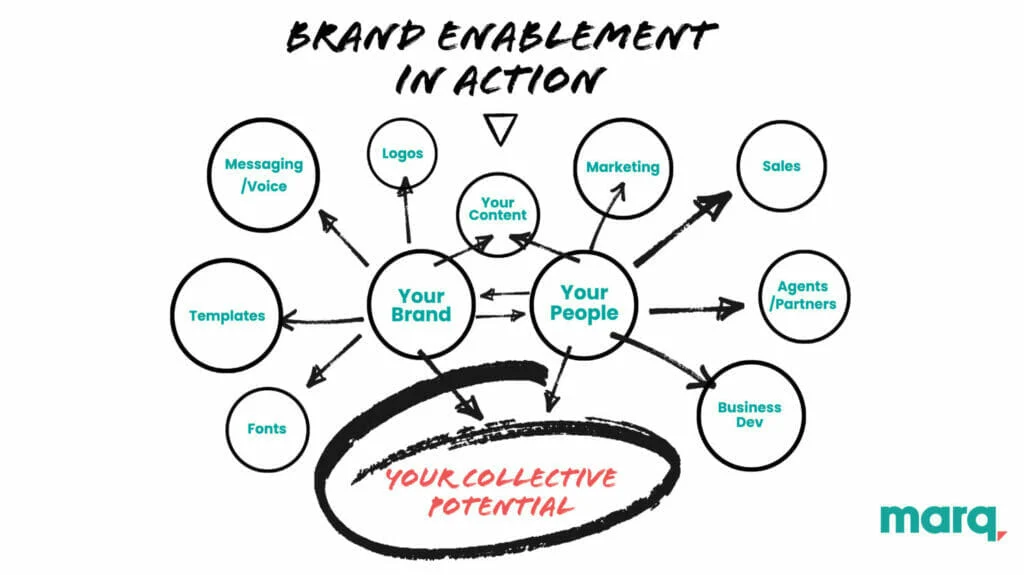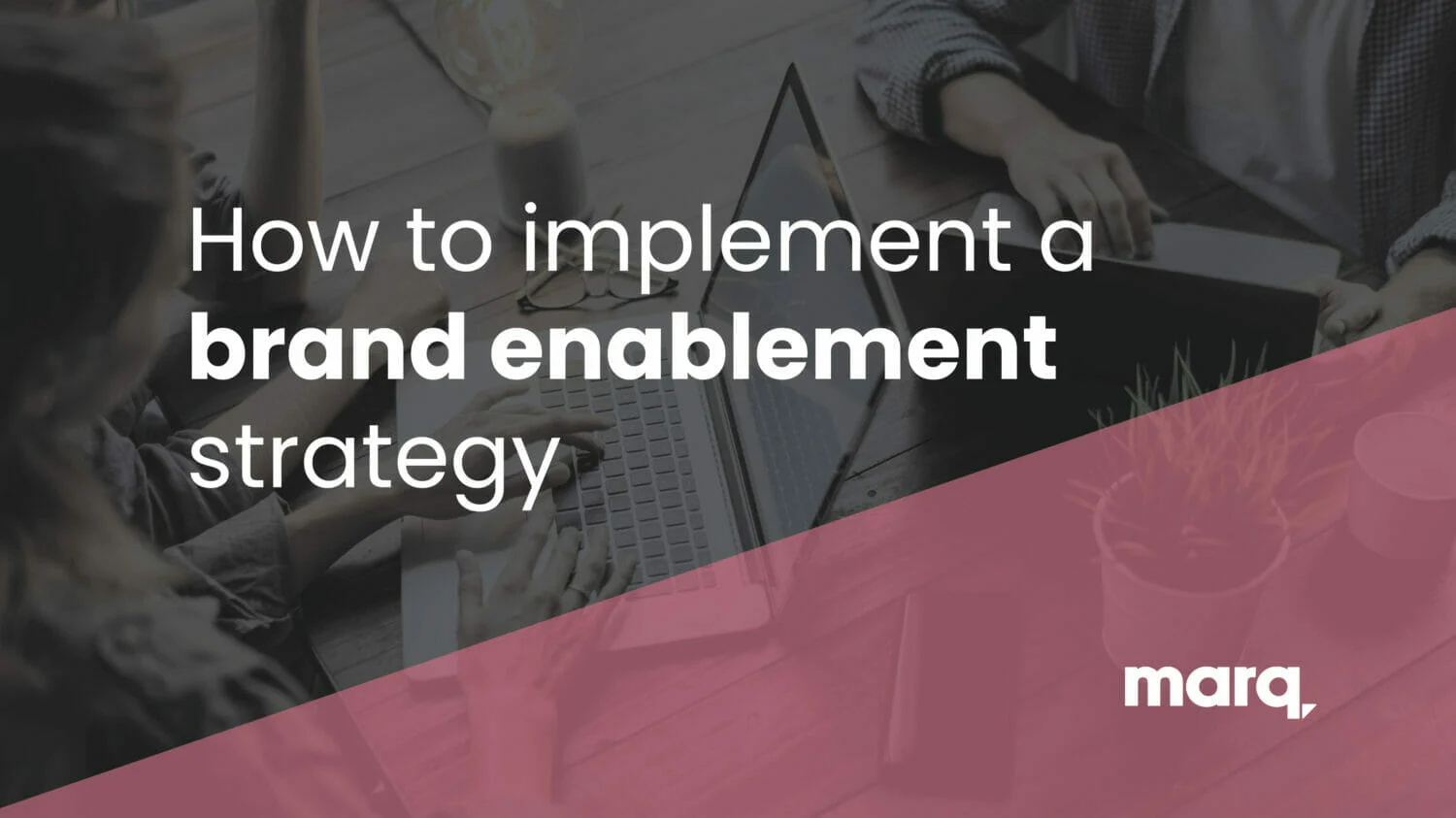We’ve been kicking around the term “brand enablement,” and the lightning-bolt level of excitement we have about it is unmatched. We can’t help but think about the teams who often feel handicapped by their own brand. We consider the number of times content is produced that doesn’t align with brand initiatives, guidelines, or even strategy. More often than not, the cause is poor communication channels or teams running in silos. Implementation of an internal brand enablement strategy is crucial to your overall brand strategy. This means brand accessibility and visibility across your organization is how you can deliver on brand strategy initiatives more effectively and efficiently.
Brand enablement is when anyone can put your brand to work, no matter their team, role, or function within your organization.
In this article, you will learn
- What is brand enablement?
- Benefits of enabling cross-functional partners with your brand
- How to enable your organization with your brand
This topic excites us and we hope it delivers the momentum you need moving into the new year. Let’s go!
What is brand enablement?
Brand accessibility, visibility, and usability across your organization are the core of what brand enablement is and can do for your business. When you equip every team with the ability to implement your brand in the channels they use daily, with confidence that they can execute? You’ve eliminated hundreds of hurdles, from creative bottlenecks to the brand/sales game of telephone.
We consider brand enablement to extend beyond a simple brand guide. Brand is more than a logo. Your brand story encompasses your visual identity, messaging, voice, and strategy. These unique brand identifiers that make up your brand get created by your people and then held by a group of brand owners, leaving the rest of your organization handicapped. We get it. Brand matters. Rogue content and off-brand materials aren’t an option.
We also know that creative and design requests are an important part of modern brand management workflows. With that said, it isn’t realistic to dump every idea on your designers to execute. Not only is so much lost in translation, but this leaves organizations in a position where they cannot act quickly, especially when their design teams are overwhelmed with requests.
Brand enablement allows you to have both. You can have a design team that executes creative ideas while fueling cross-functional teams with brand assets that they can use AND a highly productive organization that creates its own branded content to fulfill strategic initiatives.
According to CMI’s B2B Content Marketing Report for 2023,
71% of marketers believe content marketing will be more important than it was in 2022.
83% reported that differentiation from competitors is dependent on quality content production.
Bottom line, you need everyone in on strategy, aligned, enabled, and operating like a well-oiled machine. Sounds like a dream, right? Let’s talk about how you can make this dream your reality.
What are the Benefits of Brand Enablement?
Let’s face it; even the most design-savvy cross-functional team member can misinterpret or have difficulty understanding how to implement a brand effectively. The best brand strategy is one where teams’ are enabled and encouraged to take action on their ideas without concern about producing off-brand materials. We consider internal brand enablement rather crucial for organizations to produce at the pace needed to keep up with demand.
Brand enablement doesn’t just benefit your design teams, it benefits your organization as a whole. What if your designer(s) could equip your team with the brand assets, templates, content types, messaging, etc. ? What would this do for your organization’s growth?
Benefits of Brand Enablement
The benefits of enabling your people with your brand are hard to argue with- you will save time in the back-and-forth shuffle between designers and requesters, and you can also iterate on ideas faster.
Brand enablement will help you
- Save time and resources.
- Empower every team member to be a producer.
- Extend the life of your creative assets allowing for personalization, new iterations, and use across departments and teams.
- Centralize your brand, giving visibility to everything that is produced so teams have access to content and creative that can help them do their jobs better.
Think about it this way, you provide tools to your sales teams for example, to enable them to execute their roles. From industry one-sheets to pricing matrixes, empowering your sales team with the right materials and tools enables them to share your product/service and close more deals. These crucial assets greatly benefit their ability to provide customers with information. What if you did that across your entire organization, giving everyone the ability to share ideas and tap into the content that your designers are already creating?
Brand enablement encompasses those sales assets and takes it a step further. This concept creates brand awareness internally and allows any team member to access brand assets thoughtfully created by your design teams.
Content built for sales could also be incredibly impactful for growth teams. An RFP that was built for a particular customer could be repurposed for another if there was exposure and visiblity to know that it exists. Now, before you say it, we’ll say it first. We aren’t just talking about centralizing assets in the form of digital asset management. That is but one component of brand enablement, and we see the true value of your brand enablement strategy when every component is thoughtfully considered across teams.
Characteristics of a Successful Brand Enablement Strategy
It isn’t hard to immediately see the benefits of what a well-executed brand enablement strategy could do for your organization. When we think about time saved across teams and this idea that everyone in your organization is a creator, the growth potential is wildly exciting. So, how do you do it? How do you enable your people with your brand? How do you make your brand accessible and useable across your organization?
Brand enablement is made up of three core characteristics.
- Is your brand accessible?
- Are your brand activities visible?
- Is your brand usable?
Is your brand accessible?
When we think about the question, “is your brand accessible?” it is best to start with the foundational elements of your brand within your brand identity. The elements that make up your brand identity should each be included in your brand enablement strategy to ensure that your most critical brand assets are available across your organization.
Elements of brand identity include
- Your logo/wordmark
- Your fonts
- Taglines / Key Messages
- Your brand voice
- Supporting visual elements like photography, iconography, etc.
- Branded content templates
How often have you seen the wrong logo attached to a piece of content? Instead of assuming user error, consider this a failure in your brand enablement protocols. Perhaps all logos were provided when your primary logo was the only one your organization needed access to. Or, perhaps your logos were not made accessible at all, so team members had to pull your logo from the internet instead. Yikes! It sounds crazy, but these failed brand interactions happen all the time for even the most sophisticated team structures.
Establishing a brand identity takes thoughtful execution, but protecting your brand identity is often the most difficult. This is typically why creative teams are given the responsibility of protecting it and why they hold it so close. However, modern brand management and the concept of brand enablement require design teams to find creative ways to bring everyone in on brand activations.
It is next to impossible to keep up with growing content demand without enabling teams to help fill the gap. Accessibility is the first step to bringing cross-functional partners in on brand activities.
Are your brand activities visible?
Lack of visibility easily leads to duplicate content efforts, wasted resources, and mismanagement of time across your organization. It is like the ages-old saying, does the left hand know what the right hand is doing, but worse in many ways because it costs your organization money and time. When different teams are running on their own initiatives and multiple pieces of content are created that almost mirror each other or share competing messages, you risk delivering a mixed message to your audience. This error can be detrimental to brand equity over time. Further, you could miss out on opportunities by not sharing valuable assets that could be effective for your cross-functional partners.
Make your brand assets visible to all teams. This will allow anyone, like your sales reps, for example, to utilize graphics that your marketing team made. It will extend the shelf life of your content by allowing anyone to tap into content that has been created and quickly personalize them.
It will enable your organization to use the branded assets that your team worked so hard to create.
Is your brand usable?
Lastly, ensuring that the assets your creative and design teams have created are usable is essential. It is challenging to take off the designer hat and consider if a non-designer can easily handle your brand assets, but brand enablement depends on it. The expectation should not be that everyone is a designer; instead, are your designs fool-proof and created with the end creator in mind and the intended audience?
The mechanism for the usability of brand assets is often branded templates.
When you check your brand against brand enablement standards, you should ask the following questions.
- Is your brand identity accessible to teams?
- Is your brand usable across your organization?
- Do you have templates available for teams to personalize?
- Are your brand guidelines accessible?
- Can non-designers understand your brand guidelines?
- Are your brand assets (including templates) centralized and organized for teams to find what they need easily?
When you consider brand accessibility through the lens of your brand enablement strategy, you can create design assets your organization needs and will use while making those designs accessible so teams can execute confidently. How do you do this? Let’s take a look.
How do you create brand enablement at your organization?
When you shift to make brand enablement a part of your brand strategy, you’ll want to look for tools that meet the characteristics of brand enablement first and foremost. To review, these are:
- Accessibility
- Visibility
- Usability
You’ll also want to look for easy-to-use solutions that require minimal training and are easily scalable. You will need a place to store your digital brand assets, an editing tool for content personalization, and an avenue to collaborate on projects. There are several options for DAMs, design tools, template solutions, and collaboration tools, but Marq delivers on all of the above.
We are more than just a template solution for organizations. Right off the heels of our big Marq Analytics launch, which gives customers insights into which content is used and how often, we are more excited than ever about offering a brand enablement solution for organizations.

Our CEO, Owen Fuller, just shared in our 2022 Wrapped about where we are headed, and brand enablement is at the heart of it. We’d love to discuss how we can partner with you to help you do more in the new year.
Click here to schedule a 1:1 with someone from our team. Or, you can try Marq today, for free.



